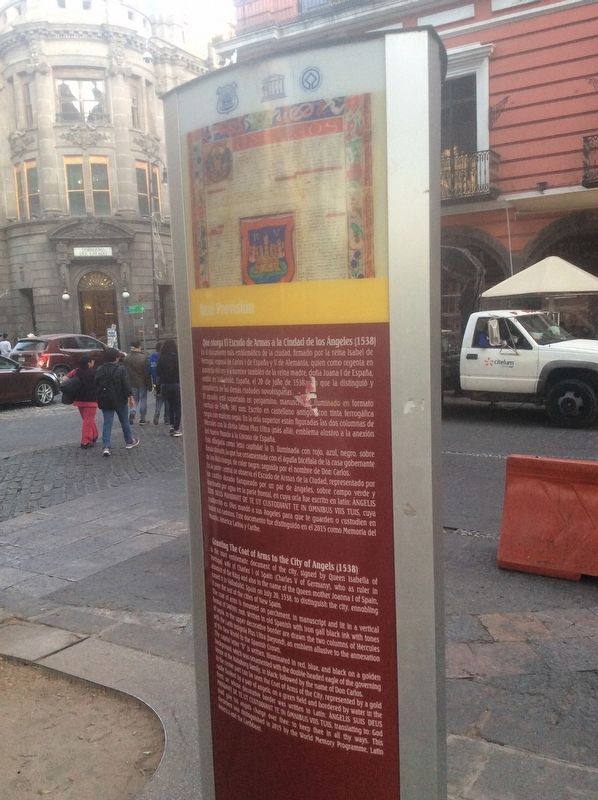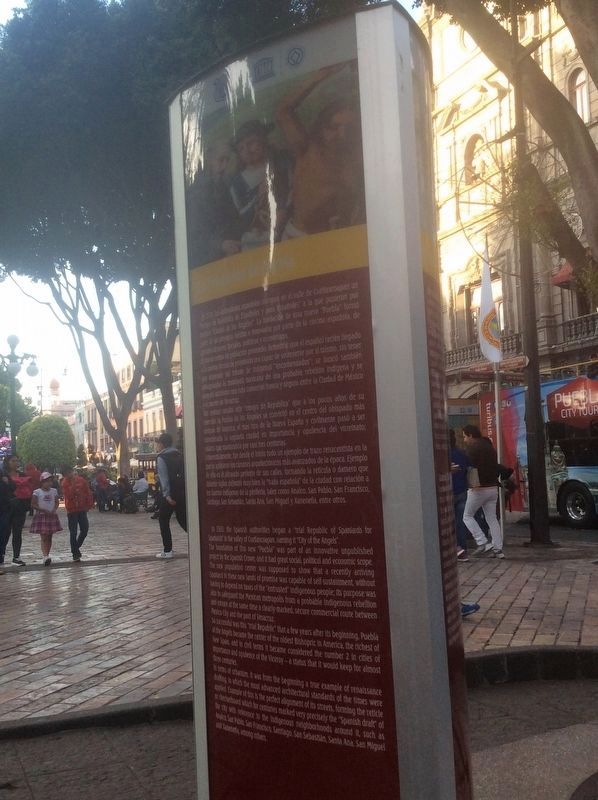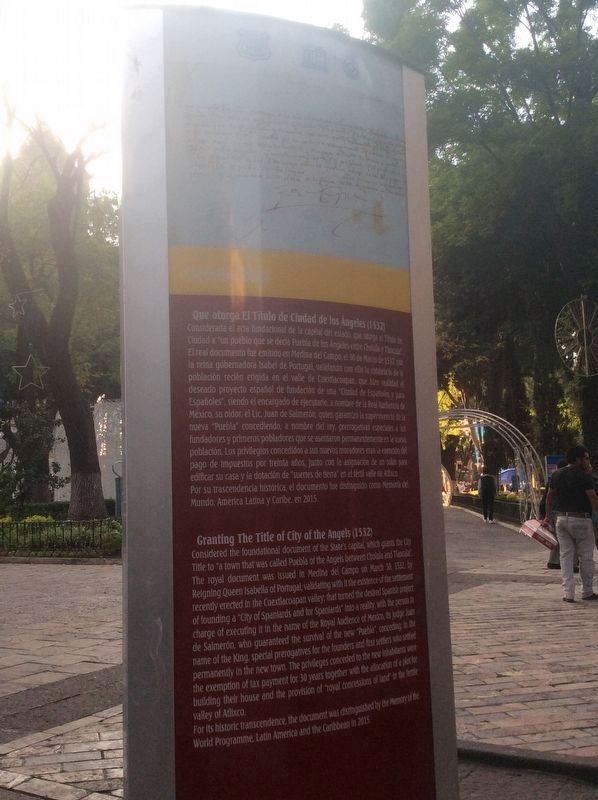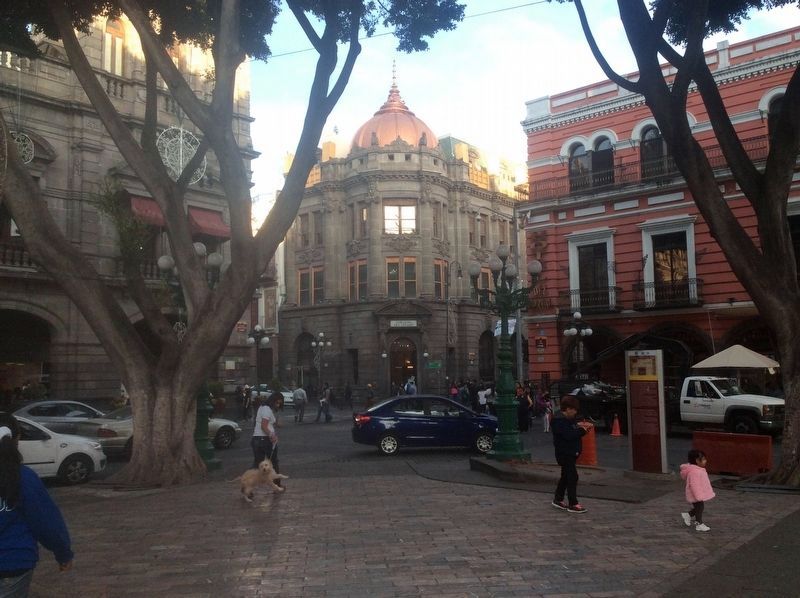Puebla, Mexico — The Central Highlands (North America)
Granting the Coat of Arms to the City of Angels (1538)
Inscription.
Que otorga El Escudo de Armas a la Ciudad de los Ángeles (1538)
Es el document más emblemático de la ciudad, firmado por la reina Isabel de Portugal, esposa de Carlos I de España y V de Alemania, quien como regenta en ausencia del rey y a nombre también de la reina madre, doña Juana I de España, emitió en Valladolid, España, el 20 de julio de 1538 con que la distinguió y ennobleció de las demás ciudades novohispanas.
El escudo, está sorportado en pergamino, manuscrito e iluminado en formato vertical de 540 x 391 mm. Escrito en castellano antiguo con tinta ferrogálica negra con matices sepia. En la orla superior están figuradas las dos columnas de Hércules con la divisa latina Plus Ultra (más allá), emblema alusivo a la anexión del Nuevo Mundo a la Corona de España.
Está dibujada como letra capitular la D, iluminada con rojo, azul, negro, sobre fondo dorado, la que fue ornamentada con el águila bicéfala de la casa gobernante de los Habsburgo, de color negro ; seguida por el nombre de Don Carlos.
En la parte central se observa el Escudo de Armas de la Ciudad, representado por un castillo dorado flanqueado por un par de ángeles, sobre campo verde y bordeado por agua en la parte frontal, en cuya orla fue escrito en latín: Ángelis suis deus manavit de te ut custodiant te in ómnibus viis tuis, cuya traducción es: Dios mandó a sus Ángeles para que te guarden o custodien en todos tus caminos. Este documento fue distinguido en el 2015 como Memoria del Mundo, América Latina y Caribe.
La Fundación de Puebla
En 1531 la autoridades españolas iniciaron en el valle de Cuetlaxcoapan un “ensayo de República de Españoles y para Españoles” a la que pusieron por nombre “Ciudad de los Ángeles”. La fundación de esta nueva “Puebla” formó parte de un proyecto inédito e innovador por parte de la corona española, de grandes alcances sociales, políticos y económicos.
El nuevo centro de población pretendió demostrar que el español recién llegado a las nuevas tierras de promisión era capaz de sostenerse por sí mismo, sin tener que depender del tributo de indígenas “encomendados”; se buscó también salvaguardar la metrópoli mexicana de una probable rebellión indígena y se aseguró asimismo una ruta comercial franca y segura entre la Ciudad de México y el puerto de Veracruz.
Tan exitoso resultó este “ensayo de República” que a los pocos años de su erección, la Puebla de los Ángeles
se convirtió en el centro del obispado más antiguo de América, el más rico de la Nueva España y civilmente pasó a ser considerada la segunda ciudad en importancia y opulencia del virreinato; estatus que mantendría por casi tres centurias.
Urbanísticamente, fue desde el inicio todo un ejemplo de trazo renacentista en la que se aplicaron cánones arquitectónicos más avanzados de la época. Ejemplo es el alineado perfecto de sus calles, formando la retícula o damero que durante siglos delimitó muy bien la "traza española" de la ciudad con relación a los barrios indígenas de la perifería,tales como Analco, San Pablo, San Francisco, Santiago, San Sebastián, Santa Ana, San Miguel y Xanenetla, entre otros.
Cédula Real
Que otorga El Título de Ciudad de los Ángeles (1532)
Considerada el acta fundacional de la capital del estado, que otorga el Título de Ciudad a “un pueblo que se decía Puebla de los Ángeles entre Cholua y Tlaxcala”. El real documento fue emitido en Medina del Campo, el 30 de Marzo de 1532, por la reina gobernadora Isabel de Portugal, validando con ello la existencia de población recién erigida en el valle de Cuextlacoapan, que hizo realidad el deseado proyecto español de fundación de una "Ciudad de Españoles y para Españoles”, siendo el encargado de ejecutarlo, a nombre de la Real Audiencia de México, su oidor, el Lic.
Juan de Salmerón, quien garantizó la supervivencia de la nueva "Puebla" concediendo, a nombre del rey, prerrogatvas especiales a los fundadores y primeros pobladores que se asentaron permanentemente en la nueva población. Los privilegios concedidos a sus nuevas moradores eran la exención del pago de impuestos por treinta años, junto con la asignación de un solar para
edificar su casa y la dotación de "suertes de tierra” en el fértil valle de Atlixco.
Por su trascendencia histórica, el documento fue distinguido como Memoria del Mundo, América Latina y Caribe, en 2015.
Granting the Coat of Arms to the City of Angels (1538)
Is the most emblematic document of the city, signed by Queen Isabella of Portugal, wife of Charles I of Spain (Charles V of Germany), who as ruler in absence of the King and also in the name of the Queen mother Joanna I of Spain, issued it in Vallodolid, Spain on July 20, 1538, to distinguish the city, ennobling it over the rest of the cities of New Spain.
The coat of arms is mounted on parchment, in manuscript and lit in a vertical format of 540 x 391 mm. Written in old Spanish with iron gall black ink with tones of sepia. In the upper decorative border are drawn the two columns of Hercules with the Latin insignia Plus Ultra (beyond), an emblem allusive to the annexation of the New World
to the Spanish Crown.
The capital letter “D” is written, illuminated in red, blue, and black on a Golden background, which was ornamented with the double-headed Eagle of the governing house of the Habsburg family, in black; followed by the name of Don Carlos.
In the center part can be seen the Coat of Arms of the City, represented by a gold castle, flanked by a pair of angels, on a Green field and bordered by water in the front, on whose decorative border was written in Latin: Ángelis suis deus manavit de te ut custodiant te in ómnibus viis tuis, translating to: God shall give his angels charge over thee; to keep thee in all thy ways. This document was distinguished in 2015 by the World Memory Programme, Latin America and the Caribbean.
The Foundation of the City of Puebla
In 1531, the Spanish authorities began a “trial Republic of Spaniards for Spaniards” in the valley of Cuetlaxcoapan, naming it “City of the Angels”.
The foundation of this new "Puebla” was part of an innovative unpublished project by the Spanish Crown, and it had great social, political and economic scope. The new population center was supposed to show that a recently arriving Spaniard in these new lands of promise was capable of self-sustainment, without having to depend on taxes of the “entrusted” indigenous people: its purpose was also to safeguard the Mexican metropolis from a probable indigenous rebellion and ensure at the same time a clearly-marked, secure commercial route between Mexico City and the port of Veracruz.
So successful was this “trial Republic” that a few years after its beginning, Puebla of the Angels became the center of the oldest Bishopric in America,the richest of New Spain, and in terms it became considered the number 2 in cities of importance and opulence of he Viceroy - a status that it would keep for almost three centuries.
In terms of urbanism it was from the beginning a true example of renaissance drafting, in which the most advanced architectural standards of the times were applied. Example of this is the perfect alignment of its streets, forming the reticle or checkerboard which for centuries marked very precisely the “Spanish draft” of the city with reference to the indigenous neighborhoods around it, such as Analco, San Pablo, San Francisco, Santiago, San Sebastián, Santa Ana, San Miguel and Xanenetla, among others.
Granting The Title of City of the Angels (1532)
Considered the foundational document of the State's capital, which grants the City Title to “a town that was called Puebla of the Angels between Cholula and Tlaxcala”. The royal document was issued in Medina del Campo on March 30, 1532 by Reigning Queen Isabella of Portugal, validating with it the existence of the settlement recently erected in the Cuextlacoapan valley; that turned the desired Spanish project of founding a “City of Spaniards and for Spaniards” into a reality, with the person in charge of executing it in the name of the Royal Audience of Mexico. Its judge Juan de Salmerón, who guaranteed the survival of the new “Puebla”, conceding, in the name of the King, special prerogatives for the founders and first settlers who settled permanently in the new town. The privileges conceded to the new inhabitants were the exemption of tax payment for 30 years together with the allocation of a plot for building their house and the provision of “royal concessions of land” in the fertile valley of Atlixco.
For its historic transcendence, the document was distinguished by the Memory of the World Programme, Latin America and the Caribbean in 2015.
Topics. This historical marker is listed in these topic lists: Colonial Era • Settlements & Settlers. A significant historical date for this entry is March 30, 1532.
Location. 19° 2.616′ N, 98° 11.842′ W. Marker is in Puebla. Marker is on Avenida Don Juan Palafox y Mendoza just east of 16 de Septiembre, on the right when traveling east. The marker is in the northeast corner of the Main Square (Zócalo) of Puebla. Touch for map. Marker is in this post office area: Puebla 72000, Mexico. Touch for directions.
Other nearby markers. At least 8 other markers are within walking distance of this marker. Portal Hidalgo (within shouting distance of this marker); The Old Portal of the Audience (within shouting distance of this marker); The Oriental Bank Building (within shouting distance of this marker); The Municipal Palace (within shouting distance of this marker); The Main Square and Fountain of San Miguel (within shouting distance of this marker); Plaza de la Democracia (about 180 meters away, measured in a direct line); The Oath to Independence in the City of Puebla... (about 180 meters away); First Speech by Francisco Madero in Puebla (about 180 meters away). Touch for a list and map of all markers in Puebla.
Credits. This page was last revised on August 12, 2018. It was originally submitted on January 19, 2018, by J. Makali Bruton of Accra, Ghana. This page has been viewed 150 times since then and 6 times this year. Photos: 1, 2, 3, 4. submitted on January 19, 2018, by J. Makali Bruton of Accra, Ghana.



